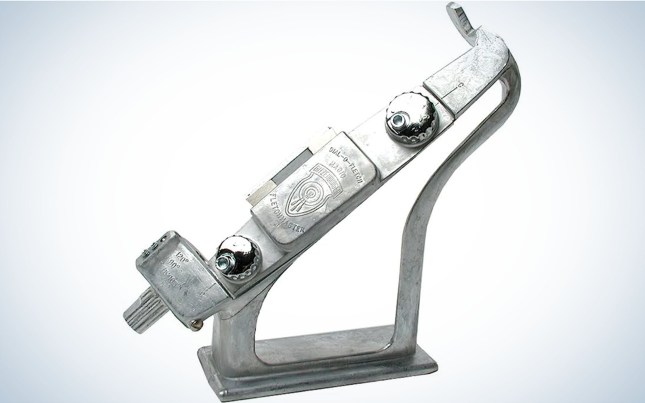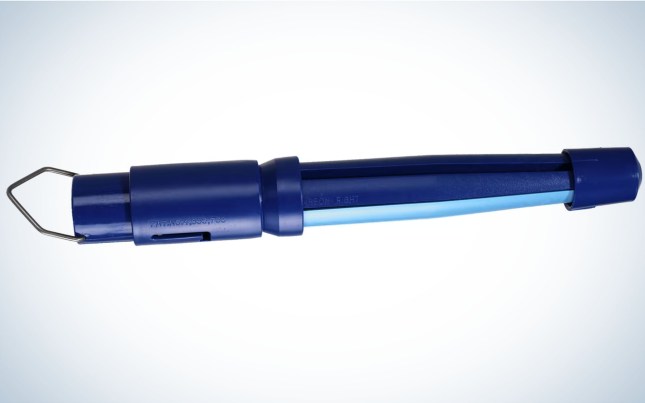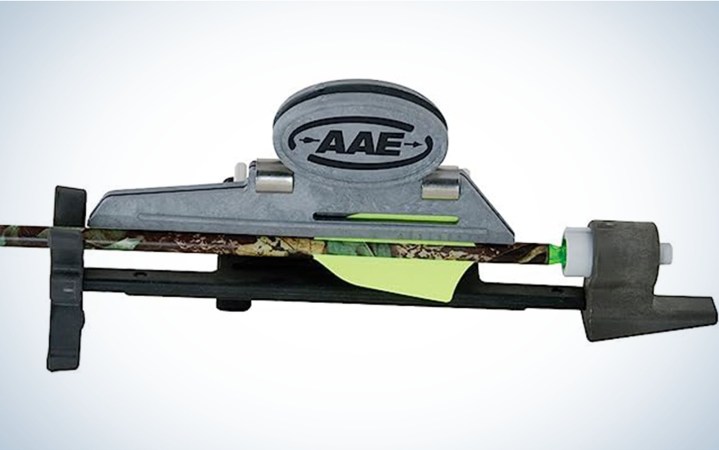We may earn revenue from the products available on this page and participate in affiliate programs. Learn More ›
More bowhunters today are looking to work on their own gear. And one project they’re really interested in is building arrows. To complete that job, you’ll need a fletching jig, which is a tool that allows you to place fletchings on your arrows. It’s a tool you might think would be largely the same from jig to jig, but it’s not. Jigs are quite different across the spectrum, and it’s imperative to find the one that’s right for you.
Some are simple and allow you to attach fletchings to an arrow without variation. Others have a wide range of adjustments and allow for lots of experimentation. To help you find the right one for you, I’ve used my years of experience working at Lancaster Archery Supply and building my own arrows to break down the best fletching jigs.
- Best Overall: Bitzenburger
- Most Precise: Last Chance Archery Vane Master Pro
- Simplest: Arizona Carbon EZ Fletching Jig
- Best Budget: AAE Fletch III Fletching Jig
Best Fletching Jigs: Reviews & Recommendations
Best Overall: Bitzenburger
Best Overall
Bitzenburger
Key Features
- Made of die-cast alloy, with all metal parts
- Self-centering arrow cradle that can be set to space three or four fletchings evenly
- Strong magnet holds the clamp securely
- Adjustment wheels allow the clamp to be angled for left or right offsets
- Offered with straight, right, or left helical clamps
- Adjusts to space three fletchings 120 degrees apart, four fletchings 75 degrees and 105 degrees, or four fletchings 90 degrees apart
Pros
- Easy to adjust and use
- Easy cleaning and resists wear caused by glue
- Once it’s set, every arrow fletched will be identical
- Can easily be used to place single fletchings if one gets damaged
Cons
- The Bitzenburger comes with one clamp, and so if you want all three, you have to buy two separately
- Difficult to set to precise and repeatable offsets
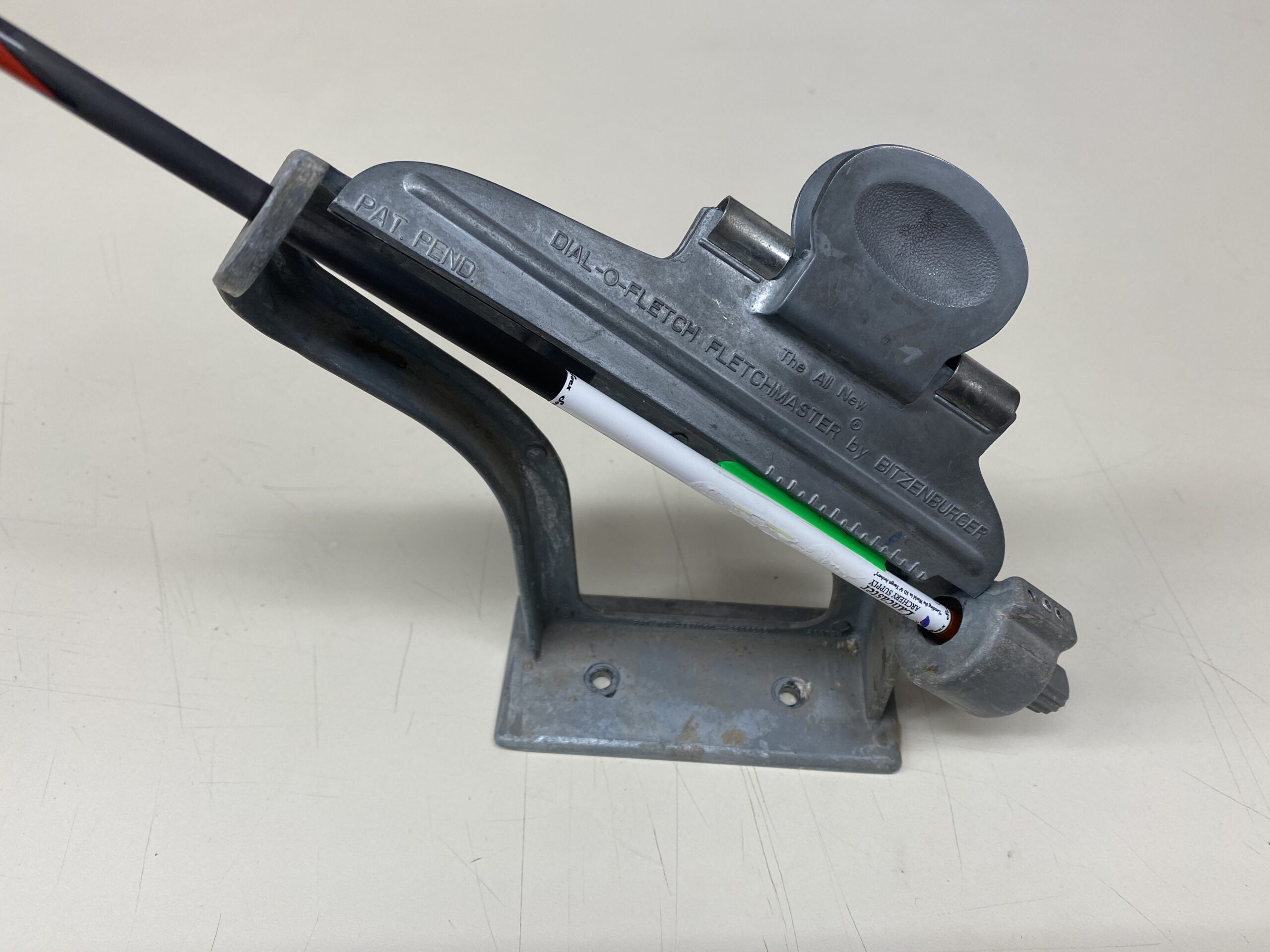
The Bitzenburger has been the choice of bowhunters and champion tournament archers for many years because it does everything you need a fletching jig to do, and using it is a piece of cake.
It’s made of die-cast alloy and has all metal parts. That means it’s easy to clean and won’t degrade due to repetitive use with cyanoacrylate glues commonly used for fletching arrows. These glues are notorious for eating away at plastic jigs and jig parts.
There’s a simple dial at the base of the jig that you can set with an Allen wrench to allow for fletching arrows with three evenly-spaced fletchings, four fletchings set at 90-degree intervals, or four set 75 and 105 degrees apart. That four-fletch, 105-degree setting gives you a flatter X shape that’s ideal if you use a blade-style arrow rest.
Equally simple to adjust with an Allen wrench is the offset for your fletchings. You can pivot the clamp position for left or right offset. If you want your fletchings set with a helical offset, you need a separate clamp for that. Bitzenberger makes a straight clamp, a right helical and a left helical. When you buy a jig, it comes with one clamp style and you can buy others separately.
The jig is almost foolproof once you get everything set the way you want. Load a vane or feather in the clamp—the Bitz can handle either—put some glue on the bottom and then attach the clamp to the jig body. A powerful magnet holds the clamp in the right place. It will spit out dozens of identically fletched arrows and last for many years, which is why it’s still the best fletching jig.
Most Precise: Last Chance Archery Vane Master Pro
Key Features
- Can fletch arrows with vanes set at precise, 0- to 5-degree offsets, or helical with right or left deflection
- Fletches arrows in three- or four-fletch configurations, although four-fletch requires an additional part that must be purchased
- Rotating wires in the clamp allow for perfect vane-to-shaft contact from vane to vane and arrow to arrow
- Fletches vanes up to 4 inches long and can be used to fletch with some thinner feathers, but it’s mainly built for vanes
- Elastic cord connects to the end of the arrow shaft to apply consistent pressure back into the arrow seat, which prevents shifting
Pros
- The repeatability of this jig is unrivaled
- Adjusts the degree of offset precisely and simply by pulling a pin
- Adjusts to right or left offset simply by turning a knob
- The rotating wires ensure perfect vane-to-shaft contact
Cons
- This is the most expensive jig on the market
The Last Chance Archery Vane Master Pro is the perfect tool for archers who are meticulous about fletching arrows. Everything about the Vane Master Pro’s construction is designed for precision and repeatability. If you build a set of arrows one day, then change the jig’s setup for different arrows, you can get it back to the original settings easily, and the performance will be identical.
It’s a jig you set on a flat surface, like a tabletop. It employs a unique clamp that slides into position on two posts. There is no play in either post, so the clamp goes to the exact same position every time it’s installed.
Fletchings are held in place on the clamp via two flexible wires that can be rotated to ensure perfect vane contact. This is a great feature because vane bases vary. The wires allow you to account for those differences.
Loosen a knob on the back of the clamp, and you can easily change the configuration of vanes from right to left offset. Move a pin between a series of holes and easily adjust the offset amount from 0-5 degrees in 1-degree increments.
The nock receiver sits in a slot on the jig base. Loosen the connection knob, and you can slide the receiver forward or back to get the vanes to sit close to the nock or farther away, depending on your preference. An elastic cord with a cup on the end is stretched out to cover the point of the arrow, which pulls the arrow into the nock receiver so it can’t slide out.
The jig comes with a knob for fletching three vanes on an arrow, evenly spaced at 120 degrees apart. You can buy separate knobs to four-fletch arrows with the vanes 90 degrees apart or four-fletch arrows with vanes 75 and 105 degrees apart.
Simplest: Arizona Carbon EZ Fletching Jig
Simplest
Arizona Carbon EZ Fletching Jig
Key Features
- Allows for attaching up to three fletchings at once
- Can be used with vanes or feathers up to 5 inches long
- Two versions: one sets fletchings straight on the shaft, and another sets them with right helical
- Compact and portable
- Can be used with micro-diameter or standard carbon arrows
Pros
- The setup is fast and foolproof
- Can be used with feathers or vanes
- Couldn’t be any simpler to use
- Affordable
Cons
- It’s plastic, so it’s not as precise as metal jigs, and glue will affect it over time
If you want a simple fletching jig, look no further than the Arizona Carbon EZ Fletch jig. I’m not sure how it could be made any simpler.
In the closed position, the jig kind of looks like a big plastic bullet. There’s a removable top that holds the three clamps in the upright position. Load a bare arrow shaft nock first into the center of the bullet, put one fletching in each of the three clamps, and then close them up. Put the top back on and hold for a 10 count. Take the top off, fold back the clamps, and remove your three-fletched arrow.
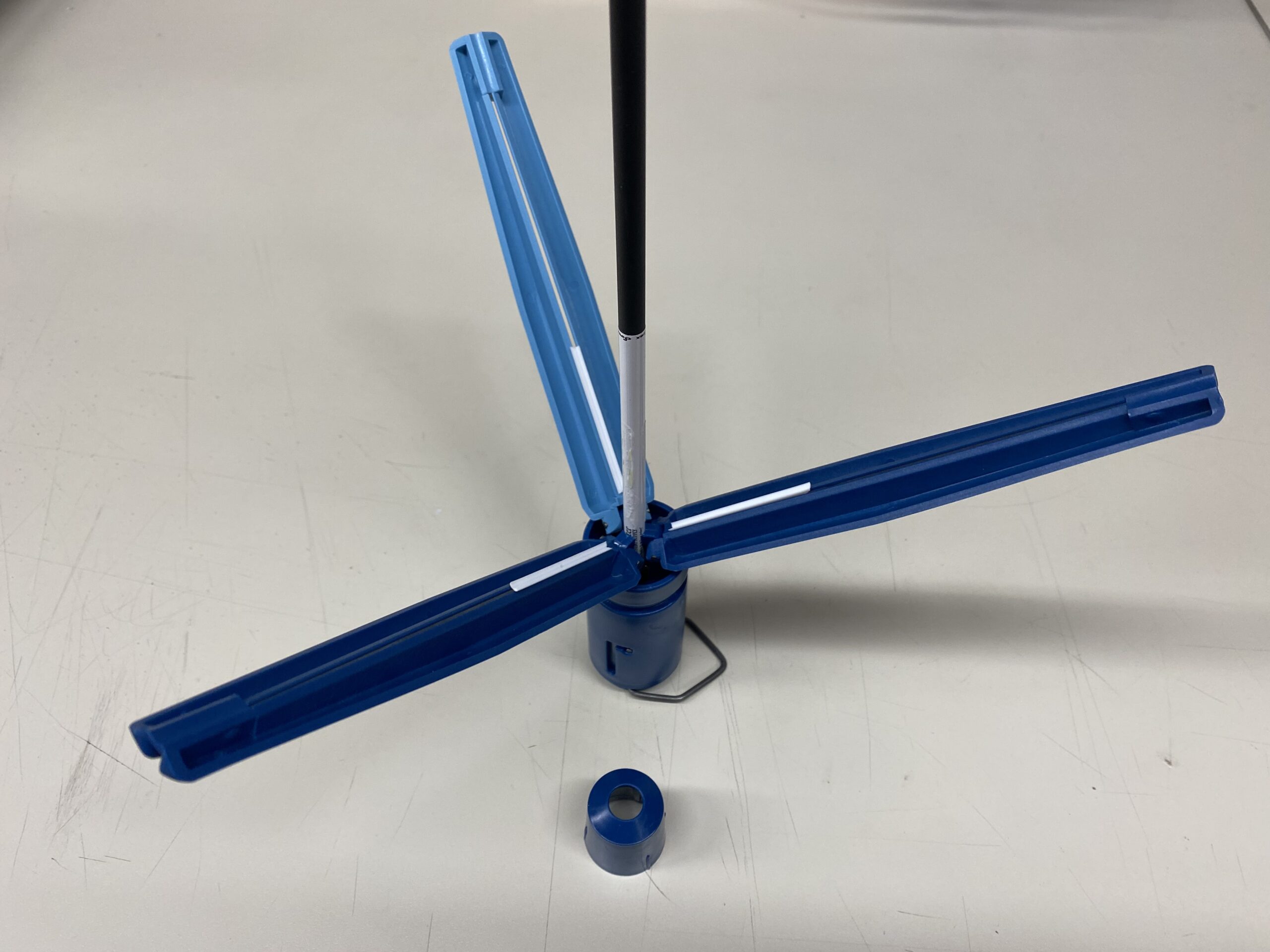
The jig can be used with feathers or vanes up to 5 inches long. One version of the Arizona EZ puts fletchings on the shaft so they run straight down the center, and another puts them on with a right helical. There’s no adjusting those configurations. They’re set either way, and that’s all they do.

As long as you used this jig to fletch the original, you can use this jig to place single fletchings on arrows in making repairs. Load your arrow in the nock receiver. Position fletchings you don’t want to replace so that you can simply close the associated clamp(s) over top of the attached fletching(s). Where you need a new fletching, load one into the clamp, apply glue, and close up the jig for that 10 count.
Best Budget: AAE Fletch III Fletching Jig
Best Budget
AAE Fletch III Fletching Jig
Key Features
- All plastic construction, with key parts infused with Teflon and silicone to prevent glue from sticking
- Fixed position to put fletchings on a shaft with 1-degree right offset
- X-stand flips to accommodate fletching smaller diameter arrows or larger diameter
- Clamp is held in place by two posts to ensure consistent fletching placement each time
- Slotted receiver allows even placement of three fletchings
- Weighs 1 ounce
Pros
- Costs $35
- Very simple to use
- Consistent
- Teflon and silicone infusions help prevent glue buildup
Cons
- Not very durable
For bowhunters who fletch a dozen arrows a year and don’t want to spend much on a fletching jig, the AAE Fletch III is a great choice.
The jig has a horizontal base featuring removable X legs at one end. You can rotate the X, which offers a skinny V on one side for smaller-diameter arrows and a wider V on the other for larger arrows.

Set the point end of the shaft in one of the Vs and the nock end into a receiver. That receiver rotates inside a circle with three notches in it. A post on the receiver fits perfectly into each notch. Rotate the receiver to each notch to evenly space three fletchings around the shaft.
The fletching clamp is connected to two posts that slide into cylinders on the jig base, so each fletching is positioned the same on the shaft each time it’s rotated. The clamp itself is spring loaded to solidly hold vanes or feathers. And it’s pitched to set fletchings at a 1-degree fight offset.
Things to Consider Before Buying the Best Fletching Jig
Your Arrow Building Needs
There are advanced, highly-adjustable fletching jigs, and there are jigs that do one thing, one way, and that’s it. What kind of bowhunter or archer are you? Never see yourself experimenting with different fletchings set in different configurations on your arrows? Then go simple. If you are a tinkerer, you’re going to want one that allows you to use plastic vanes and feathers of varying lengths set at different angles left or right and one that allows you to go three-fletch or four.
If you don’t need all those adjustments, then find one that fletches the way you want and go with that, knowing that it will do what you need it to and nothing more. There’s nothing wrong with that.
Generally, metal jigs last longer than plastic ones. Over time, the glues used for fletching will deteriorate plastic parts, which can lead to inconsistent fletching. A metal jig can be used and cleaned over and over and over and stay as sharp and precise as the day you first took it out of the box.
Simplicity
Check the manufacturer’s instructions for fletching an arrow and see how easy or difficult it seems to set up the jig and to put a vane or feather in the clamp and an arrow in the receiver. That should all be simple—even on advanced jigs that allow the most versatility. If you have to change a lot of parts or take a lot of steps to set the jig, move on. Fletching is not a complicated process, and so the jig should be easy to use.
Precision
You want precise movements in the moving parts. “Slop” or “play” in the moving parts can lead to inconsistent fletching placement on the arrow shaft. You want to be able to place each fletching exactly where you want it and in exactly the same configuration from arrow to arrow.
FAQs
Fletching jigs cost anywhere from $30 to $350. Those are the extremes, however. Most jigs are going to fall in the $80 to $150 bracket.
There are fletching jigs that allow you to work with one fletching at a time, and there are others that allow you to work with multiples—three is most common. Which you choose depends on you. No doubt, loading three fletchings into a jig and then clamping them all onto the shaft at the same time is faster than working with one fletching at a time.
But if you need to replace just one fletching to make a repair, it might be easier to work with the single-fletching jig. Also, if you have a three-fletching jig and you want to try a four-fletch configuration, you’ll need a new jig. Many single-fletching jigs can be adjusted to set three or four fletchings on an arrow.
Offset creates arrow spin. Fewer degrees of offset means less spin. More offset means more spin. Spin creates stability to some extent. A lot of arrow spin at short ranges can be good, but at long distances, that same spin can actually destabilize the arrow. So you might want some arrows with a lot of spin and some arrows with less, depending on where and what you’re hunting.
Arrows naturally spin in different directions coming off different bows. If you want to match the natural spin of an arrow, it’s good to be able to adjust between right and left.
When setting a fletching at a right or left offset, the fletching is loaded into a straight clamp and simply placed on the shaft at an angle left or right of center. For helical offset, a curved clamp is used to curl the vane around the arrow at an offset angle. The curving increases the rate of spin.
Final Thoughts on the Best Fletching Jigs
When the wind is howling in the dead of winter, or the rain is falling in buckets during summer, there’s no better way to pass the time than fletching arrows. Fletching can be as simple or as complicated as you want to make it. The best fletching jig is the one that does what you want it to, and that can withstand the amount of fletching you plan to do, and you’ll never be bored on those “inside” days again.
- Best Overall: Bitzenburger
- Most Precise: Last Chance Archery Vane Master Pro
- Simplest: Arizona Carbon EZ Fletching Jig
- Best Budget: AAE Fletch III Fletching Jig

